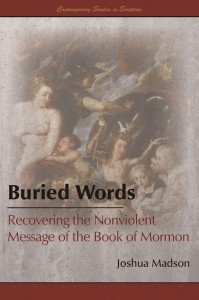
Some time ago, I had the opportunity to participate in a large group in-service meeting for teachers working with LDS youth. The presentation focused upon the need teachers have in today’s world of information accessibility to help students answer difficult questions. The presenter gave a passionate lecture, drawing heavily upon 2 Peter 1:16. The text presents Peter, the Lord’s apostle, making the assertion,
“We have not followed cunningly devised fables, when we made known unto you the power and coming of our Lord Jesus Christ, but were eyewitnesses of his majesty.”
The presenter then used this verse to suggest that teachers in the Church need to help students avoid the cunningly devised fables that often appear online and instead rely upon the prophets of Jesus Christ, who like Peter himself, are witnesses of Christ’s divinity.
The presenter concluded by referencing the names of two prominent LDS historians whom he had heard on separate occasions testify to the fact that they had never learned anything in their studies that had ever caused them to have doubts that Joseph Smith was a true prophet; youth, therefore, should never doubt their spiritual convictions. It was a great sermon, delivered with much love and sincerity.
Towards the end, however, I felt the need to share an observation that I too felt passionately about. “Thank you so much,” I said sincerely, “may I offer a bit of candid feedback?” The presenter smiled and graciously allowed me to share my own thoughts. “I’m not convinced,” I said, “that when LDS youth face challenges due to information they’ve learned through the internet that in most instances they’re struggling with ‘fables.’ What they’re mostly struggling with are fact; facts like Joseph Smith really did marry very young women and other men’s wives, or that Brigham Young was married to as many as 55 women, or that critical biblical scholars universally recognize that the author of 2 Peter wasn’t, in fact, Peter, an eyewitness to Jesus’ life and teachings.”
“Instead of worrying about fables,” I said, “I believe that we need to do a better job helping our students process challenging facts into their religious convictions. I believe we need to alter our approach and stop giving students the impression that there is never any good reason to doubt or question their faith. Instead, we need to help students incorporate questioning as a meaningful contribution to a spiritual journey. We need to stop creating the crisis.”
I still hold to these convictions. And as an institution, the LDS Church is certainly striving to accomplish this goal. In the past year, we’ve witnessed the release of shockingly open Gospel Topic essays on the Book of Abraham and Joseph Smith’s polygamy. The Church has also announced a major shift in upper-division curriculum courses for LDS youth attending both BYU and the Church’s Institute of Religion programs. Changes have come to the High School seminary curriculum as well, with teachers discussing Joseph Smith’s translation of the Book of Mormon and the Mountain Meadow massacre. So change is in the air. There is clearly a strong institutional desire to help LDS youth incorporate challenging facts into their religious convictions.
And yet, as the famous Mormon philosopher J. Bonner Ritchie insightfully observed, change is never easy. In any institution there will always be two groups in conflict with one another. Progressives who recognize that in order to survive, the institution they love must evolve and adapt; and conservatives who want to preserve the way things were, who feel threatened by change. To clarify, I’m not suggesting that everyone in the institution fits into this dichotomy, nor that one side is intrinsically right and the other wrong. As Ritchie observes, ultimately both groups are necessary and must learn to work together in order for an institution to thrive (he uses the example of Abraham Lincoln who as a successful leader possessed both “conservative” and “liberal” attributes). Ritchie’s observations on this matter provide a helpful framework for what we’ve recently witnessed in terms of online discussions concerning Mormon studies.
There has never been a more exciting time for those interested in the academic field of Mormon studies. Courses in Mormon studies have been taught at Harvard, UPenn, Virginia, Arizona, Arizona State, Southern Alabama, Georgetown, Utah State, Utah Valley University, the University of Utah, etc. Books focusing on Mormonism have been published by university presses at Oxford (probably the premier venue for Mormon studies, publishing close to a dozen in the last few years), Harvard, UNC, Nebraska, Tennessee, Yale, Oklahoma, Indiana, and Missouri.
In 2012, the University of Virginia announced plans to hire a chair in Mormon studies (currently occupied by Historian Kathleen Flake). The Claremont Graduate University has for several years now had the Howard W. Hunter Chair in Mormon studies position, Utah State has the Arrington Chair of Mormon History and Culture (currently occupied by Dr. Philip Barlow), and presently Dr. Boyd Peterson serves as the program coordinator over Mormon studies at Utah Valley University.
In response to these exciting shifts, BYU’s own Maxwell Institute has attempted to broaden their academic discussion of Mormonism by inviting non-LDS scholars to share their views on Mormon history and scripture in a respectful academic dialogue in the pages of BYU journals. Yet as exciting as these changes are to some, as should be expected, not everyone believes that these changes move Mormonism in a positive direction.
BYU professors Daniel Peterson and William Hamblin, for example, have openly criticized academic courses that teach the Bible or the Book of Mormon from either a literary or historical perspective. While they state that historic-literary approaches have some “value,” Hamblin and Peterson argue that when these books are taught, they should fundamentally be taught as “scripture.” In a related critique, BYU professor Ralph Hancock has repeatedly expressed his concern that LDS scholars are becoming too “secular” in producing studies (or teaching classes) that bracket certain traditional Mormon claims. Perhaps inspired in part by Hancock’s critique, BYU professor John Gee has recently posted two provocative posts on his personal blog addressing this same concern.
After surveying the statistics for the loss of LDS youth, Gee writes:
“The big threat to the youth in the Church is not Evangelicals but secularists. They account for more than twice as many losses as those to all other religions combined. We lose more youth to secularism during the college years (and the statistics include those who do not go to college) than we do in the high school years. Signs of secularization during the time when youth are attending the university should be of particular concern to church leaders.”
Gee then followed this observation with a not-so indirect criticism of what he perceives as the new direction assumed by his employer, the Maxwell Institute. After discussing how religious institutions of higher learning have historically lost their unique identify when trying to expand their academic focus, Gee writes:
“Though the specifics may differ, this general experiment has been conducted many times with the same general result. Insanity, it has been said, is to repeat the same experiment over and over and expect different results.”
In other words, by trying to expand the academic conversation concerning Mormonism, BYU’s Maxwell Institute is doomed. It is caving in to “secularism,” the greatest threat LDS youth face in today’s world.
I have no doubt that these concerns are all sincerely felt by good men with deep religious convictions. But make no mistake about it; they are also calculated efforts designed to fan the flames of concern for those who feel threatened by the types of changes we’ve seen recently in both Mormon studies and the institutional Church.
Speaking personally, I’m certainly sympathetic with those who fear that LDS youth may abandon their religious convictions due to “secularism.” In fact, I agree with Dr. Gee that this is the single greatest threat that LDS youth face in today’s world of skepticism and increased information accessibility. But returning to my opening story, my own concern is that efforts to fight against the progress of Mormon studies and academic discussion by painting these efforts as the antithesis to a spiritual journey will only increase the loss of LDS youth to “secularism.”
Since secularism is the greatest cause for LDS youth abandoning their faith, the last thing we should do is force them into a corner where they have to decide between their Mormonism and the moral convictions they’ve gained through secular studies (even if these convictions are wrong, they should be handled with patience and love). And yet, this corner is precisely the direction that these commentators would move us towards. For Latter-day Saints, the answer to Hancock’s recent online query, “To Whom Shall We Go,” should not be “apologetics” or “Mormon studies.” The answer is “truth.”
If Mormonism is truly what our founding prophet proclaimed, namely a religion that seeks to “receive truth, LET IT COME FROM WHERE IT MAY,” then the type of paradigms (apologetics versus academics) we employ are entirely irrelevant. Can a Latter-day Saint receive truth through an academic inquiry that brackets traditional assumptions? If as Joseph Smith proclaimed, “the first and fundamental principle of our holy religion is, that we have the right to embrace all, and every item of the truth, without limitation or without being circumscribed or prohibited by the creeds and superstitious notions of men,” then in my mind, the answer is an absolute, “yes.” From this angle, academic inquiry is not as Hancock portrays it, a “secular” pursuit. Instead, it is a spiritual journey. I maintain that moving in this direction, the one outlined by the prophet Joseph Smith himself, is the way to save LDS youth from leaving Mormonism for secularism. After all, it was Joseph Smith himself who turned to secular biblical scholarship to inform his own religious perspectives.
Granted, through academic inquiry that brackets traditional assumptions, some LDS youth will come to some non-traditional conclusions concerning LDS history, scripture, or moral practices. But the problem is that in the past, we have too often given them the impression that if they hold non-traditional views, they must either abandon those beliefs or deny their religious faith. No wonder we’re losing so many youth to the battle of “secularism.”
I would like to offer an alternative perspective, and to do so by picking up on one of Hancock’s greatest online concerns, LDS “intellectuals” who for moral reasons come to support same sex marriage. I believe that a better course in this circumstance than the one Hancock offers which paints “intellectuals” into a corner where they must abandon either their religion or their moral convictions would be to encourage the following approach:
1. Remind youth of the blessings that come directly into their lives as a result of their Mormon faith. These might include family, community, service opportunities, and sacred rites of passage. If Mormonism, in fact, brings them happiness and helps them feel connected to divinity then it’s certainly worth retaining in their lives.
2. Remind youth that the Church is very much a rough-stone rolling (to borrow the famous analogy); that leaders have made mistakes in the past and that if they’re correct, that supporting same-sex marriages is the correct moral path, then the Church will eventually make changes similar to those related to the Priesthood ban. The goal of Mormonism is self-improvement. By staying with the institution that has blessed their’s and their families’ lives (even when they disagree with Church leaders on this issue), they will help their faith community, their family, to develop spiritually.
3. Remind youth, however, to be humble, to recognize that on this or any other topic, they may, in fact, be wrong and Church leaders correct. Part of being spiritually minded is remaining open to the reality that we’re not always right in our moral convictions. We need prophetic guidance, even when it is mistaken or incomplete, to act as a guide by which we can question our own assumptions.
4. Finally, encourage them to be patient, because either they or the institutional Church will eventually change. What a tragedy it would be to lose out on all of the blessings that Mormonism brings to our lives because through critical study an individual comes to a different conclusion than Church leaders on a particular issue. Struggling with such challenges (for both the Church and the individual) is simply part of the spiritual journey. It’s not something to fear. It’s something to embrace as part of our quest for spiritual self-reliance upon divinity. Hang on to the good, and either you or the Church will eventually gain further light and knowledge.
I strongly believe that this basic pattern could be applied to any given issue that arises through critical thinking or exposure to academic inquiry. And in an age of increased secularism and information accessibility, this is they way to save LDS youth. To again borrow Hancock’s approach as an example, we cannot force the youth of the Church into a corner where they feel compelled to choose between Mormon studies and apologetics, or between moral convictions and Mormonism. Instead, we must allow for doubts, mistakes, and non-traditional beliefs to be incorporated into our spiritual journey.
To put it simply, to save the LDS youth in a secular age, we need to make room on the pew for feminists, critical scholars, and intellectuals.











